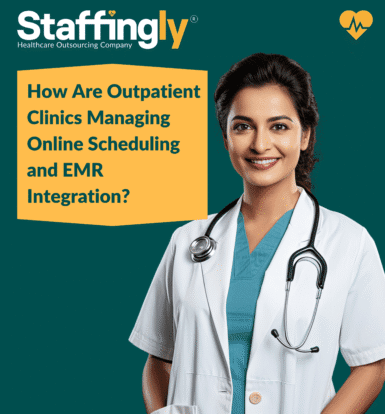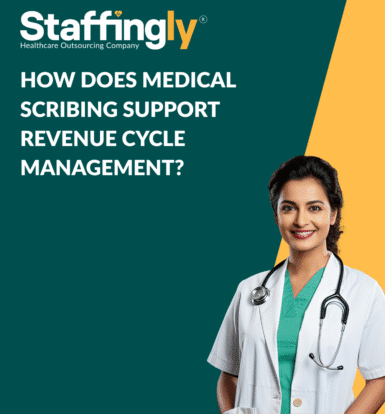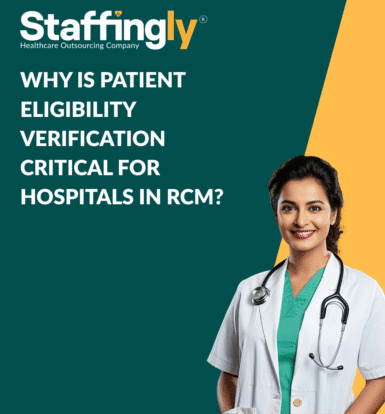On-Demand Outsourcing BPO Services for Healthcare Providers With 24/7 Coverage!
Save up to 70% on staffing costs!
Browse Specialty Staffing Services
How Are Outpatient Clinics Managing Online Scheduling and EMR Integration?
A frustrated patient summed it up best: “I had to call the clinic, sit on hold, give my insurance info verbally, and still had no idea what I was going to owe until I checked in.” That single quote represents what many outpatient clinics are still battling — outdated scheduling workflows, disconnected EMRs, and zero upfront insurance checks. In a recent healthcare forum, professionals across physical therapy, behavioral health, and outpatient practices shared what’s actually happening behind the scenes —

Outsourcing and Technology: Practical Solutions for Healthcare Challenges
Healthcare professionals are raising critical questions about operational inefficiencies that drain clinical time and patient satisfaction. One practitioner captured the frustration perfectly: “there’s a long-standing problem with setting appointments with GPs and psychologists, and complaints that medical receptionists are rude almost anywhere.” The discussion reveals how technology and strategic outsourcing could transform healthcare operations. The Documentation Time Drain Healthcare professionals consistently report that administrative documentation consumes valuable clinical hours. One emergency medicine physician explained the scope: “Most documentation could

When Insurance Premiums Rise Faster Than Paychecks?
Healthcare professionals across the country are bracing for sticker shock. One family practitioner captured the mounting frustration: “I am at 22% of my income for health insurance premiums for my family of three and am not looking forward to the increase in premiums yet again.” The numbers are staggering. If Congress lets ACA subsidies expire, premiums across marketplace plans will jump an average of 114%. Even employer-based plans aren’t safe, with projected increases of 6.5% – the biggest spike in

How Does Medical Scribing Support Revenue Cycle Management?
Revenue Cycle Management (RCM) is the backbone of every healthcare practice. It covers the entire process of managing patient care revenue from appointment scheduling to final payment collection. However, one of the most critical steps in this process is accurate documentation. Without precise clinical records, hospitals and clinics face claim denials, payment delays, and compliance risks. This is where medical scribing plays an important role. Medical scribes help doctors by documenting patient encounters in real time. Their work ensures that

How Can Outsourcing Revenue Cycle Management Improve Efficiency For Doctors?
Managing the financial side of healthcare is often as challenging as treating patients. For doctors and healthcare providers, the process of billing, coding, claims submission, and payment collection is critical but time-consuming. This is where Revenue Cycle Management (RCM) outsourcing comes into play. By outsourcing RCM, doctors can streamline administrative tasks, reduce errors, and focus more on patient care. Understanding Revenue Cycle Management Revenue Cycle Management refers to the complete financial process that healthcare providers follow to manage patient accounts

Why is Patient Eligibility Verification Critical for Hospitals in RCM?
In the healthcare industry, one of the first and most essential steps in the Revenue Cycle Management (RCM) process is patient eligibility verification. Hospitals and healthcare providers rely on accurate verification to ensure that patients are covered by their insurance plans before services are delivered. This step not only prevents claim denials but also protects hospitals from revenue losses and ensures a smooth patient experience. What is Patient Eligibility Verification? Patient eligibility verification is the process of confirming a patient’s

Why Is Interoperability Important in Electronic Prior Authorization?
Prior authorization (PA) is a process used by insurance companies to ensure that medical services, medications, or procedures are medically necessary and covered under a patient’s health plan. While it was designed to control healthcare costs and encourage appropriate care, prior authorization often becomes a bottleneck, delaying treatment and frustrating both providers and patients. Electronic Prior Authorization (ePA) has been introduced as a solution to reduce paperwork, speed up approvals, and bring efficiency into the process. However, the full benefits

Can Hospitals Safely Share Emergency Room Wait Times with Patients?
A recent healthcare discussion caught fire when one user asked: “Why can’t hospitals just post emergency room wait times online — or at least show a simple green, yellow, red system?” Patients argued it would help them choose where to go faster. But healthcare professionals quickly jumped in with real-world context: ERs aren’t like restaurants or hair salons — they run on triage, not time slots. One emergency medicine provider summed it up perfectly: “If you’re waiting, it means you’re
 Book a Demo to Build Your Team Today!
Book a Demo to Build Your Team Today!


 Read Case Studies
Read Case Studies 



 Virtual Medical Assistants
Virtual Medical Assistants



